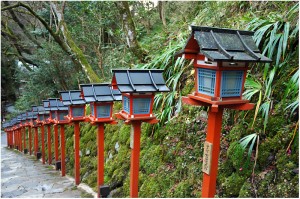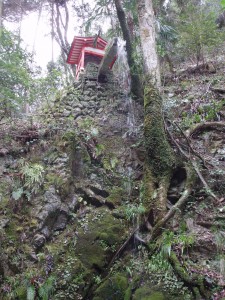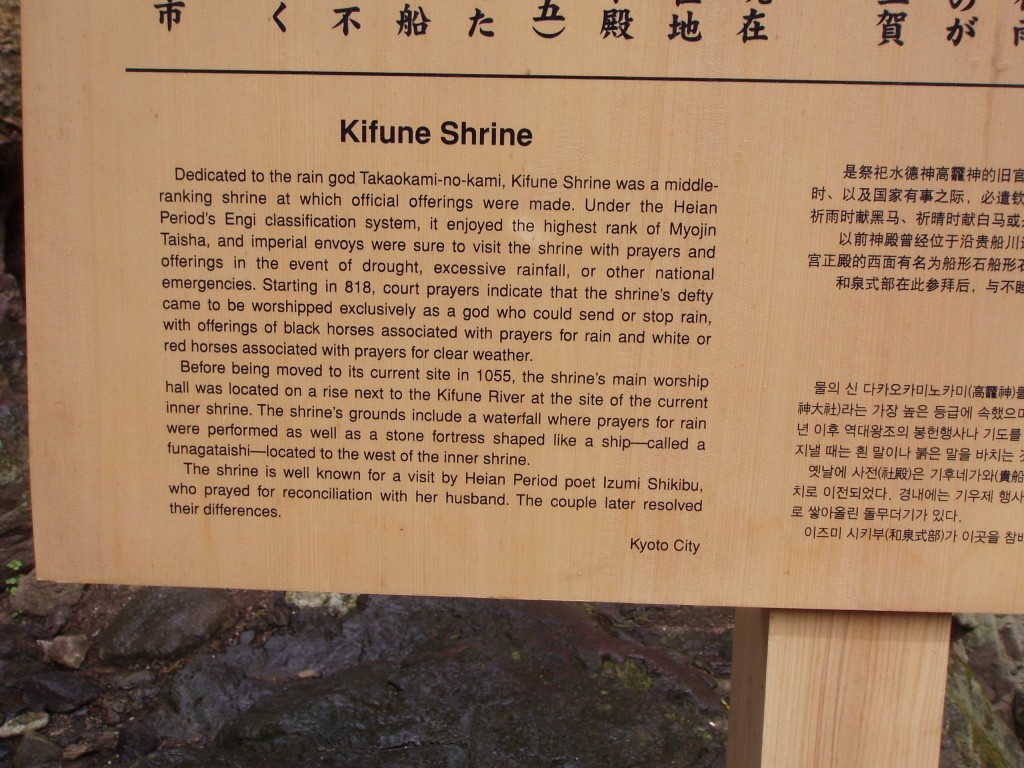
Shrine entrance
Kibune Jinja is small but special; in Heian times it was designated one of the top 22 shrines. It’s noted for being dedicated to a water kami and is located just above the river. There is water gushing all around and down through the rocks on the side of the mountain. It also practices ‘water divination’, whereby you place a piece of paper on the surface of the water and your fortune becomes visible.

Water omikuji (fortune paper)
Enshrined here are Kuraokami no kami and his wife Mizuhonone no kami, both considered water gods. After the capital was moved to Kyoto, the emperor would visit here for rain ceremonies. If rainfall was needed, a black horse would be offered to the shrine, if dry weather was needed, a white horse.
The shrine’s English language pamphlet is entitled The Water God (Okami no kami), and inside it says ‘This Kami is not the God of water itself (the God of water itself is Mizuhanome-no-Kami) but as the provider of water to others, such as in the form of rain and snow. As the plants and trees grow, the water is kept in the ground. Okami-no-Kami is in Mt Kifune and controls the mysterious works of nature.’
The pamphlet states that there are 2500 branch shrines around Japan. ‘While some areas have bountiful water, other areas suffer a shortage of water and still others are exposed to the dangers of floods. However, Okami-no-kami remains enshrined in all of those places today,’ concludes the pamphlet. Here, one feels, would be an ideal centre for a campaiging style of environmental Shinto to emerge.

Holy water
For me the most intriguing item is a rock formation in the shrine compound in the shape of a boat, with a pole sticking up to represent a mast (perhaps a himorogi descent for the kami). This is in reference to the legend of a court princess who came up the river in search of the source (probably in the Nara era). The place where she found it was where the original shrine was built. Afterwards she turned into a dragon and flew up into the sky. Her boat was covered with stones, placed in the shrine building and hidden from view. There is however a rock boat model in the present shrine grounds.
A boat made of rock might seem a most unsuitable vessel for river navigation! I believe this to be connected, however, with the ancient belief that the sky was made of rock and that gods sat in huge stone thrones in the heavens. Occasionally bits of the sky fell off and hurtled towards earth in the form of meteorites. When the gods wanted to descend, they used rock-boats. Similarly they used iwakura (sacred rocks) in which to manifest themselves. The princess turned kami would therefore have been at home in a rock-boat.
The shrine is well worth a visit for anyone coming to Kyoto, offering in addition a pleasant forty minute walk over the hill to ancient Kurama where tengu roam the woods and the warrior-hero Yoshitsune grew up while plotting to take revenge against his enemy, Taira no Kiyomori. Kurama Temple incidentally, and very oddly for a Budddhist temple, worships a spirit descended from the planet Venus thousands of years ago called Mao-son. Since this was most likely a meteorite, there are links to the rock-boat of Kibune. It’s proof positive of the close links that in the past combined Buddhist and Shinto faiths. Both you might say were rooted in the rock of ages!
(For further information on the nature worship of Kurama and Kibune, see the separate posting under Shrine Visits.)

Kibune shrine noticeboard

Kibune Jinja also stands out in my memory as being one of the shrinking number of jinja that possess fiber rather than nylon shimenawa. Kudos to them for striving to keep the cycles unbroken.